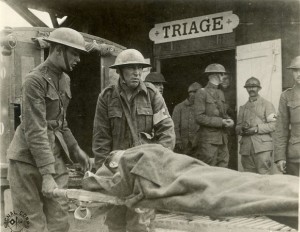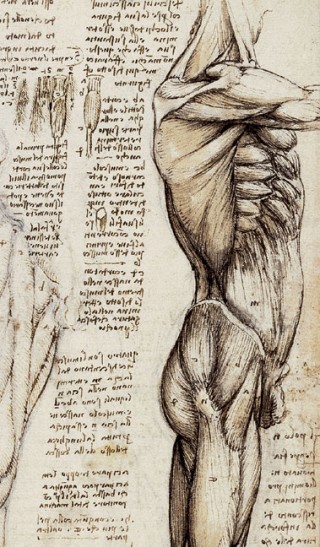The Ethics of Medical Triage
August 15, 2010 1 Comment
One of the most difficult ethical dilemmas in medicine is allocation of resources in a crisis. Even in America, a resource-rich country with a plenitude of tertiary care medical centers, our resources are limited. An article in the Health Blog of The Wall Street Journal on August 4, Institute for Safe Medication Practices: Drug Shortages ‘Unprecedented’, discusses the recent national shortage of emergency

Systematic medical triage began during WWI when surgical treatment of injuries had a better than not chance of saving a life. However, there were a limited number of surgeons and surgical facilities and this and other necessities led to the very reasonable system of triage. Dakota Voice, 2009
medications, including propofol and intravenous lasix. In terms of patient volume, an article in The New York Times on August 9, Vital Signs – Who Visits the Emergency Room?, indicates that one out of every five Americans visited the emergency room at least once in 2007 – and the numbers continue to rise. Not only are emergency department visits rising, but ICU admissions continue to rise. Last fall during the H1N1 outbreak, American hospitals witnessed an acute rise in ICU admissions. Thus, because of medication shortages and hospital bed limitations, American hospitals have faced small “medical crises” of their own, primarily in the emergency department and the ICU.
To manage this, some medical ICUs use a rating system to triage patients on a daily basis. They receive a number, from 1 to 5, based on (1) a patient’s need for intensive care and (2) his or her likelihood of receiving the greatest benefit from intensive care. This numeric scoring system assigned by residents, fellows, and attendings on a daily basis, to ensure that patients move to step-down units and regular floor beds as quickly as possible. It also serves as practice for the time when a hospital must face a mass casualty situation and triage patients appropriately. In the emergency department, disaster plans and triage systems are discussed on a regular basis. Emergency physicians are well aware that, in the face of a disaster, patients will come through their doors first. The mindset of the emergency physician is geared towards triage: even on a regular day in the ED, emergency physicians triage sicker patients to critical care sections quickly to give them the best chance of survival. The ED uses a triage system primarily based on chief complaint, age, vital signs, comorbidities, and an overall “gestalt” of the patient’s condition.
There are several approaches to medical triage. The most basic approach, which EMS applies in mass casualty situations, is to triage patients according to a color scheme. Red indicates patients who will die unless they are treated immediately. In a broader sense, this includes patients with airway or respiratory compromise, severe burns, cardiac problems, severe bleeding, open chest or abdominal wounds, severe head injuries, and severe medical problems. Although these conditions can be broadly interpreted, a good triage physician will classify patients as red primarily based on vital signs and Glasgow Coma Score – these patients are the sickest of the sick and are in absolute need of immediate medical care. Yellow patients need treatment in the next 12 to 24 hours and close observation in the interim, in order to ensure they do not transition to the red category. Green is reserved for the “walking wounded” who will need medical care eventually but do not need urgent treatment. Black is used for the deceased or for patients whose injuries are so severe that they will not survive – again, even here there is room for interpretation.
The main concept behind triage is not to save everyone right away, but (1) to prioritize patients based on their likelihood to benefit from treatment and (2) to provide greatest benefits to the largest number of people. The underlying assumption here is that this triage method is applied only when resources are limited. At this point, the more difficult questions become (1) who should make triage decisions? and (2) what method should we use to triage as best we can? In an article about ventilator distribution during the flu pandemic last year, Your Chance to Weigh In on Ventilator Rationing for a Severe Flu Pandemic, Sheri Fink, a journalist with medical school training, raises some of these questions and emphasizes the importance of public awareness of triage decisions, but she does not propose any solutions. In an excellent interview in February on NPR, How The Ethics Of Triage Play Out In Haiti, emergency physician Michael Millin from Johns Hopkins Hospital discusses the approach triage during the earthquake in Haiti. The main principle, he explains, is to distribute resources to patients who are more likely to live – and who are more likely to benefit from treatment. He discusses a patient with end-stage tuberculosis whom he had to deny oxygen – he needed to prioritize other patients who were more likely to benefit from that oxygen in the long-term.
Fink writes an article, Doctors face ethical decisions in Haiti, that recounts the story of a young patient in Haiti who, like the gentleman with tuberculosis, was also denied oxygen. We know that this young woman needs oxygen chronically, but Fink does not offer us the patient’s medical diagnosis and overall prognosis, nor does she compare this patient’s prognosis to those of patients who did receive oxygen. She asks the question, “Is this choice between serving the individual patient and the broader community of patients really so stark?” The answer at this time, based on the nature of the crisis in Haiti and the lack of supplies or a well-established health care delivery system, is a resounding yes. And in this situation, we must acknowledge that there will be countless individual tragedies – but we must still have an organized approach to distribute resources effectively. We cannot, unfortunately, give every patient the care that they need and deserve.
The ethics of triage are not straightforward. Let’s begin with some basic definitions. Triage comes from the French word trier, which means “to sort.” A multiple casualty incident (MCI) is defined as a disaster in which patient care resources are overextended but not overwhelmed – these disasters, such as an automobile crash that involves 5 or more patients, may stress local resources. In these incident, triage focuses on identifying patients with the most life-threatening injuries. The definition of a mass casualty event (MCE) is a disaster in which patient care resources are overwhelmed and cannot be supplemented – in these incidents, triage focuses on identifying patients with the greatest likelihood of survival. The second scenario, the MCE, is far more challenging both from logistical and ethical perspectives. We rarely encounter an MCE in the United States, even in the most extreme examples of civilian catastrophes. According to an article in Military Medicine, The Dynamics and Ethics of Triage: Rationing Care in Hard Times, even our worst casualties – September 11, the massacre at Columbine High School, and the Oklahoma Federal Building bombing – did not meet criteria for an MCE. The MCE is more commonly seen in combat situations or in other countries where medical resources are limited.
The goal of triage in the MCE is to treat patients with the greatest chance of survival with the least expenditure of time and resources. But this is controversial. Even the categories in which patients are placed – red (immediate), yellow (delayed), green (minimal), and black (expectant) – are not universally agreed upon. The line between black and red is not always straightforward. And who should be making these classifications? Should the triage officer be a physician with experience in mass casualties, an emergency physician who is more experienced at rapid triage, or a trauma surgeon who has more expertise in evaluating trauma patients?
When developing answers to these questions, we must consider and try to preserve four bioethical principles: autonomy, beneficence, non-maleficence, and justice. Triage necessitates compromising these principles to some degree. First, in a MCE, autonomy must sometimes be compromised for the greater good. Patients cannot always dictate their care – we simply may not have enough resources to accommodate all of their wishes, collectively. Furthermore, in an emergency setting, patients do not always have the capacity to make medical decisions. In this situation, we must curtail their autonomy to preserve beneficence – a patient who is on the verge of dying, but is agitated and refuses treatment, still needs medical care. In contrast, patients with minimal injuries who demand immediate treatment cannot be accommodated – as physicians, we need to care for the sickest patients first. We should, however, do our best within the limits of a situation to preserve autonomy. We can do this by informing patients of our decisions and by allowing them to participate in their care if possible.
The principle of beneficence, the requirement that a patient benefit from care, is extremely important in a casualty. However, it is difficult to apply this principle for every patient: physicians may need to compromise the care of one patient in order to provide care that will benefit another patient. Furthermore, according to Repine in The Dynamics and Ethics of Triage (cited above) the only definitive way to decide if beneficence was preserved is to analyze outcomes of all mass casualty patients and to compare that with their predicted outcomes and triage status, and then to evaluate beneficence for each patient and for the group.
Non-maleficence, the principle that a physician should first do no harm, is a principle that should be applied in a casualty situation. This principle is more easily preserved. The last principle, justice, is critically important. In order to preserve justice, a triage officer – or perhaps a small group of triage officers – should make decisions about patient care and distribution of resources. Triage protocols need to be developed before casualties occur, so that appropriate, clear, concise guidelines can be followed. Triage plans should be developed by a group of people who collectively (1) have experience with medical triage in casualty situations (2) can offer the best medical opinion about a patient’s prognosis and likelihood to benefit from treatment (3) have a background in medical ethics. The public should be informed of triage planning and should have the opportunity to participate in these discussions.
These are only some preliminary ideas on the subject, and they serve as the beginning of a discussion rather than as hard and fast evidence. In light of both recent catastrophes and a hospital system which continues to experience high patient volume, it will be important to continue these discussions as we move forward.


Thank you – this post addresses a pressing and under-discussed issue. I keep thinking about this problem (which has been on my mind since Sheri Fink’s series) and I hope you will, too. Writing about these issues is one thing, but sorting out among the hypothetical realities will be tricky indeed.